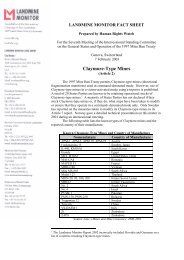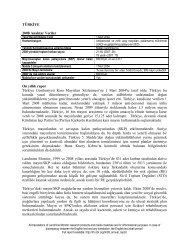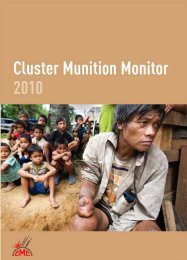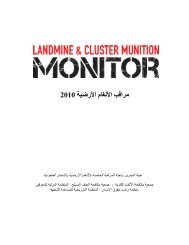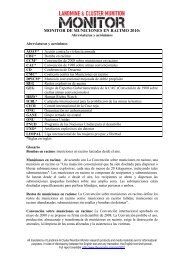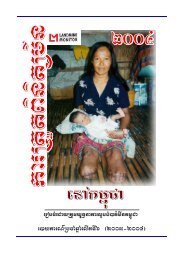Download PDF - Landmine and Cluster Munition Monitor
Download PDF - Landmine and Cluster Munition Monitor
Download PDF - Landmine and Cluster Munition Monitor
Create successful ePaper yourself
Turn your PDF publications into a flip-book with our unique Google optimized e-Paper software.
<strong>Cluster</strong> <strong>Munition</strong> <strong>Monitor</strong> 2012<br />
Exporters <strong>and</strong> recent transfers<br />
While the historical record is incomplete <strong>and</strong> there are large variations in public information available, the US has<br />
probably been the world leader in exports, having transferred hundreds of thous<strong>and</strong>s of cluster munitions containing tens<br />
of millions of submunitions to at least 30 countries. 104<br />
<strong>Cluster</strong> munitions of Russian/Soviet origin are reported to be in the stockpiles of 33 states, including many that<br />
inherited stocks after the dissolution of the USSR. 105 The full extent of China’s exports of cluster munitions is not known,<br />
but unexploded submunitions of Chinese origin have been found in Iraq, Israel, Lebanon, <strong>and</strong> Sudan.<br />
Non-signatories Brazil, Israel, South Korea, Slovakia, Turkey, Ukraine <strong>and</strong> the US are known to have exported cluster<br />
munitions since 2000. States Parties Chile, France, Germany, Moldova, Spain, <strong>and</strong> the UK exported cluster munitions<br />
prior to their adoption of the Convention on <strong>Cluster</strong> <strong>Munition</strong>s.<br />
In the reporting period, the <strong>Monitor</strong> reviewed the following new information on transfers:<br />
• According to a May 2012 document provided to the <strong>Monitor</strong> by Chile, there were “no other applications or<br />
new exports authorizations” for cluster munitions after the year 2001. 106 According to Ministry of Defense<br />
information, Chile exported cluster munitions to five countries between 1991 <strong>and</strong> 2001. 107<br />
• On 15 September 2011, the arms expo Defence & Security Equipment international (DSEi) in London closed<br />
the Pakistan Ordnance Factory st<strong>and</strong> <strong>and</strong> Pakistan’s Defence Export Promotion Organisation pavilion after<br />
promotional material was found at both locations listing cluster munitions available for sale, including the<br />
155mm extended range (base bleed) DPICM projectiles containing 45 submunitions <strong>and</strong> the 155mm M483A1<br />
cluster munition containing 88 submunitions, both manufactured by the Pakistan Ordnance Factory. 108 Pakistani<br />
authorities reportedly stated that cluster munitions were not offered for sale by Pakistan at DSEi. 109<br />
Similar concerns were raised during the 2009 DSEi arms fair, when Pakistan Ordnance Factory was found to<br />
be advertising the 155mm extended range (base bleed) DPICM cluster munition. 110<br />
Non-signatories Georgia, India, Pakistan, Slovakia, Turkey, <strong>and</strong> the United Arab Emirates (UAE) are among the<br />
recipients of cluster munitions exports since 2005.<br />
At least two states that have not joined the Convention on <strong>Cluster</strong> <strong>Munition</strong>s, the US <strong>and</strong> Singapore, have enacted an<br />
export moratorium. Estonia is not known to have exported cluster munitions, but in May 2012, a Ministry of Defense<br />
official informed the <strong>Monitor</strong> that Estonia is considering enacting a national moratorium on the transfer of cluster<br />
munitions. 111<br />
New transfer information arising from recent use<br />
It is not known who supplied the cluster munitions that were allegedly used in Sudan <strong>and</strong> Syria in 2012 or when they<br />
were transferred, but both states are known stockpilers of cluster munitions. Libya’s use of cluster munitions in April<br />
2011 led to the revelation that Spain transferred 1,055 MAT-120 cluster munitions containing 22,155 submunitions to<br />
Libya in 2006 <strong>and</strong> 2008, before Spain adopted the convention. 112 Thail<strong>and</strong>’s use of NR269 <strong>and</strong> M85 cluster munitions in<br />
the February 2011 border conflict with Cambodia may indicate recent transfer, as these cluster munition types were not<br />
previously known to be stockpiled by Thail<strong>and</strong>.<br />
Sensor Fuzed Weapons<br />
The US has announced several new sales of CBU-105 Sensor Fuzed Weapons in the reporting period, following earlier<br />
announcements of sales to India <strong>and</strong> Saudi Arabia. These weapons are prohibited under the Convention on <strong>Cluster</strong><br />
<strong>Munition</strong>s, but are not covered by the US export ban because they have a reported UXO rate of less than 1%. In the<br />
104<br />
Argentina, Australia, Bahrain, Belgium, Canada, Colombia, Egypt, Denmark, France, Germany, Greece, Honduras, India, Indonesia, Israel,<br />
Italy, Japan, Jordan, Morocco, the Netherl<strong>and</strong>s, Norway, Oman, Pakistan, Saudi Arabia, South Korea, Spain, Thail<strong>and</strong>, Turkey, the UAE, <strong>and</strong><br />
the UK, as well as Taiwan.<br />
105<br />
Algeria, Angola, Azerbaijan, Belarus, Bulgaria, Republic of Congo, Croatia, Cuba, Czech Republic, Egypt, Hungary, Georgia, Guinea,<br />
Guinea-Bissau, India, Iran, Iraq, Kazakhstan, North Korea, Kuwait, Libya, Macedonia FYR, Moldova, Mongolia, Peru, Pol<strong>and</strong>, Romania,<br />
Slovakia, Syria, Turkmenistan, Ug<strong>and</strong>a, Ukraine, Uzbekistan, <strong>and</strong> Yemen. In addition, Russian cluster munition remnants have been identified<br />
in Sudan, although the government has denied having a stockpile.<br />
106<br />
Letter from the Brigadier General Roberto Ziegele Kerber, Director-General of National Mobilizaton, Ministry of Defense, 18 May 2012.<br />
107<br />
Brazil, Colombia, Turkey, United Arab Emirates, <strong>and</strong> the US. <strong>Cluster</strong> <strong>Munition</strong> <strong>Monitor</strong> notes on Chilean Air Force document signed by<br />
Chair of the Joint Chief of Staff of the Air Force, “Exports of <strong>Cluster</strong> Bombs authorized in the years 1991-2001,” dated 23 June 2009, taken<br />
during <strong>Monitor</strong> meeting with Juan Pablo Jara, Desk Officer, Ministry of Defense, Santiago, 11 April 2012. Translation by the <strong>Monitor</strong>.<br />
108<br />
The United Kingdom is a State Party to the Convention on <strong>Cluster</strong> <strong>Munition</strong>s so the references to equipment were found to breach UK<br />
Government Export Controls <strong>and</strong> DSEi’s contractual requirements.<br />
109<br />
Saba Imtiaz, “London exhibition controversy: Pakistan says no brochures listed cluster munitions,” The Express Tribune, 21 September 2011.<br />
http://tribune.com.pk/story/256773/london-exhibition-controversy-pakistan-says-no-brochures-listed-cluster-munitions/.<br />
110<br />
“Evidence submitted by the UK Working Group on Arms (UKWG),” Strategic Export Controls (UK Parliament), November 2010. http://<br />
www.publications.parliament.uk/pa/cm201011/cmselect/cmquad/writev/arms/m5.htm.<br />
111<br />
Email from Kadi Silde, Adviser, International Co-operation Department, Ministry of Defense, 2 May 2012.<br />
112<br />
Five MAT-120 cluster munitions were transferred in October 2006 <strong>and</strong> another 1,050 in March 2008. Statement of Spain, Convention on<br />
<strong>Cluster</strong> <strong>Munition</strong>s Intersessional Meetings, Geneva, 29 June 2011.<br />
20



